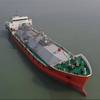Personnel and units of the U.S. military and Republic of Korea (ROK) Combined Forces Command (CFC) conducted their annual combined and joint exercise, Reception, Staging, Onward-movement, & Integration and Foal Eagle 2006 (RSOI/Foal Eagle 06) March 24-31.
RSOI and Foal Eagle are Korean-theaterwide computer-simulated and field exercises designed to evaluate and improve the U.S. and ROK forces' ability to coordinate the procedures, plans and systems necessary to defend the ROK in a contingency. It focuses on ground maneuver, air, naval, expeditionary, and special operations, as well as command and control training.
Foal Eagle involved more than 70 U.S. and ROK Navy ships and more than 100 aircraft from all services of both the U.S. and ROK armed forces.
“The participation of both nations’ navies demonstrates the solid commitment to the ROK/U.S. alliance and strengthens the combat readiness of ROK and U.S. supporting forces through combined and joint training,” said Rear Adm. James P. Wisecup, commander, U.S. Naval Forces Korea (CNFK).
The participating U.S. naval units included USS Abraham Lincoln (CVN 72) from Carrier Strike Group (CSG) 9 with embarked aircraft from Carrier Air Wing (CVW) 2, as well as Destroyer Squadron (DESRON) 9 ships USS Mobile Bay (CG 53), USS Russell (DDG 59) and USS Shoup (DDG 86).
U.S. 7th Fleet assets included the Commander, Amphibious Squadron (COMPHIBRON) 11 staff embarked on USS Essex (LHD 2), USS Juneau (LPD 10), USS Harper’s Ferry (LSD 49), USS Houston (SSN 713), USS Guardian (MCM 5), USS Patriot (MCM 7), USS Chancellorsville (CG 62), USS Safeguard (ARS 50), as well as the DESRON 15 staff embarked on USS Curtis Wilbur (DDG 54), and ships USS Vandegrift (FFG 48), USS Stethem (DDG 63), USS Fitzgerald (DDG 62), USS Gary (FFG 51) and USS John S. McCain (DDG 56).
“This yearly exercise is all about working closely with our Republic of Korea counterparts,” said Capt. Robert Girrier, commodore of Destroyer Squadron 15. "The training is comprehensive and robust, and provides Sailors the opportunity to hone our skills."
The ships perfected their warfighting skills for working together in a complex multi-threat environment that included close-air-support for ground, air-to-air defense exercises, maritime interoperability training, expeditionary operations and counter-special operations.
“Foal Eagle is one of the few opportunities to do multi-warfare training with both U.S. and ROK units on a large scale across all of our warfare areas to include anti-submarine, anti-air and anti-surface warfare. It flexed our joint and combined capabilities while stressing the importance of the ROK/U.S. alliance,” said Capt. Gary Waring, assistant chief of staff for operations for CNFK.
Both navies showed how closely they work in both exercises and operations and the joint commitment to security in the Korean Theater of Operations.
In addition to the rehearsed scenarios throughout the exercise, Safeguard and ROK navy ship ROKS Pyong Taek (ATS 27) conducted a real-world salvage operation for a U.S. Air Force F-16C fighter aircraft that crashed off South Korea’s coast March 14. Both ships were taking part in the 21st combined diving and salvage exercise (SALVEX 06).
“There is no better training for the dynamic and challenging circumstances of actual salvage operations than to participate in such an operation together with a highly capable ally,” said Lt. Cmdr. Doyle Hodges, Safeguard’s commanding officer.
Crew members from Safeguard took part in the recovery with help from scuba divers from Mobile Diving and Salvage Unit 1.
Foal Eagle was more than exercises involving the coordination of ships and aircraft. Many of the ships embarked and hosted their counterparts as part of the Navy’s liaison naval exchange program. They assisted the ships with communications and provided support throughout all the different events, while at the same time conveying interesting ROKN perspectives.
Moreover, the exercise was a chance for Sailors to meet the citizens of Korea and experience the culture, local cuisine, shopping, and take part in community relations projects and sightseeing in the ports of Donghae, Pyongtaek, Pohang, Chinhae and Busan.
CNFK is the regional commander for the U.S. Navy in the Republic of Korea and provides leadership and expertise in naval matters to area military commanders, including the Commander for the United Nations Command, the Republic of Korea and U.S. Combined Forces Command, and Commander, U.S. Forces Korea. CNFK also serves as liaison to the Republic of Korea Navy, the Combined Forces Commander staff in armistice and in wartime and to the Commander, U.S. 7th Fleet, based in Yokosuka.
By Journalist 1st Class David McKee, Commander, U.S. Naval Forces Korea Public Affairs
Source: NavNews
Subscribe for
Maritime Reporter E-News
Maritime Reporter E-News is the maritime industry's largest circulation and most authoritative ENews Service, delivered to your Email five times per week










